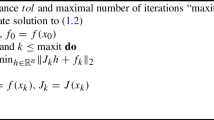Abstract
A new sub-pixel correlation peak locating algorithm for PIV analysis is introduced. The method is theoretically consistent with the method of continuously shifting interrogation sub-windows by fractional displacements, which has proven to be an effective way to reduce the bias error associated with integer pixel aliasing, or ‘peak-locking’. However the proposed algorithm performs continuous window shifting in the spatial frequency domain using the ‘shift’ property of the Fourier transform, thus it is equivalent to interpolating the original digital image with the Fourier transform reconstruction. Synthetic and real PIV images are used to test the new algorithm’s performance relative to that of traditional (non-iterative) peak-finding methods and other peak-locking reduction algorithms, such as the continuous window shifting technique. The resultant bias error of the proposed algorithm is smaller (by an order of magnitude in some cases), and importantly, the periodic nature of the bias error, the characteristic signature of ‘peak-locking’, is eliminated as long as the discrete particle images have been sampled at a rate greater than the Nyquist sampling frequency. Moreover, this new algorithm is shown to be computationally efficient and it converges faster than the competing algorithms.















Similar content being viewed by others
References
Batchelor GK (1953) The theory of homogeneous turbulence. Cambridge University Press
Bracewell R (1998) The Fourier transform and its applications, 3rd edn. McGraw-Hill
Cowen EA, Monismith SG (1997) A hybrid digital particle tracking velocimetry technique. Exp Fluids 22:199–211
Fincham AM, Delerce G (2000) Advanced optimization of correlation imaging velocimetry algorithms. Exp Fluids 29:S13–S22
Gui L, Merzkirch W (2000) A comparative study of the MQD method and several correlation-based PIV evaluation algorithms. Exp Fluids 28:36–44
Gui L, Merzkirch W, Fei R (2000) A digital mask technique for reducing the bias error of the correlation-based PIV interrogation algorithm. Exp Fluids 29:30–35
Gui L, Wereley ST (2002) A correlation-based continuous window-shift technique to reduce the peak-locking effect in digital PIV image evaluation. Exp Fluids 32:506–517
Hart DP(2000) PIV error correction. Exp Fluids 29:13–22
Huang HT, Fiedler HE, Wang JJ (1993) Limitation and improvement of PIV. ii. particle image distortion, a novel technique. Exp Fluids 15:263–273
Liao Q, Cowen EA (2002) The information content of a scalar plume—a plume tracing perspective. Environ Fluid Mech 2:9–34
Lourenco L, Krothapalli A (1995) One the accuracy of velocity and vorticity measurements with PIV. Exp Fluids 18:421–428
Lourenco L, Krothapalli A (2000) True resolution PIV: A mesh-free second order accurate algorithm. In: Proceedings of the 10th international symposium on applications of laser techniques to fluid mechanics, Lisbon, Portugal, July 2000.
Mydlarski L, Warhaft Z (1996) On the onset of high-Reynolds-number grid-generated wind tunnel turbulence. J Fluid Mech 320:331–368
Nogueira J, Lecuona A, Rodriguez PA (2001a) Identification of a new source of peak locking, analysis and its removal in conventional and super-resolution PIV techniques. Exp Fluids 30:309–316
Nogueira J,Lecuona A, Rodriguez PA (2001b) Local field correction PIV, implemented by means of simple algorithms, and multigrid versions. Meas Sci Technol 12:1911–1921
Prasad AK, Adrian RJ, Landreth CC, Offutt PW (1992) Effect of resolution on the speed and accuracy of particle image velocimetry interrogation. Exp Fluids 13:105–116
Raffel M, Kompenhans J (1994) Error analysis for PIV recording utilizing image shifting. In: Proc 7th Int Symp Appl Laser Tech Fluid Mech, page 35.5, Lisbon, Portugal, 14–16 July 1994
Scarano F, Riethmuller ML (2000) Advances in iterative multigrid PIV image processing. Exp Fluids, Suppl: S51–S60
Sholl MJ, Savas O (1997) A fast Lagrangian PIV method for the study of general high-gradient flows. In: Aerospace Science Meeting & Exhibit, 35th, Reno, NV, Jan 6–9, 1997. AIAA, pp 97–493
Wereley ST, Meinhart CD (2001) Second-order accurate particle image velocimetry. Exp Fluids 31:258–268
Westerweel J (1993) Digital particle image velocimetry: theory and application. PhD Thesis, Delft University
Westerweel J (1998) Effect of sensor geometry on the performance of PIV interrogation. In: The International Symposium on Applications of Laser Technique to Fluid Mechanics, Lisbon, Portugal, 13–16 July 1998
Westerweel J, Dabiri D, Gharib M (1997) The effect of a discrete window offset on the accuracy of cross-correlation analysis of digital PIV recording. Exp Fluids 23:20–28
Willert CE, Gharib M (1991) Digital particle image velocimetry. Exp Fluids, 10:181–193
Acknowledgements
The authors gratefully acknowledge the financial support of the Office of Naval Research (Grant Nos. N00014-98-1-0774 and N00014-99-1-0591, Dr. Keith Ward, program manager).
Author information
Authors and Affiliations
Rights and permissions
About this article
Cite this article
Liao, Q., Cowen, E.A. An efficient anti-aliasing spectral continuous window shifting technique for PIV. Exp Fluids 38, 197–208 (2005). https://doi.org/10.1007/s00348-004-0899-7
Received:
Accepted:
Published:
Issue Date:
DOI: https://doi.org/10.1007/s00348-004-0899-7




